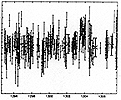For Educators

Types of Sources in the ASM Catalogue
?
An active galaxy is one containing a massive black hole at its center. The accretion of gas onto this black hole produces an enormous amount of energy at all wavelengths of the electromagnetic spectrum.
AM Her Type CV
AM Her type cataclysmic variables are magnetic polar white dwarf binary stars. This means that the magnetic field of the white dwarf is so strong that the material pulled off the companion star does not even form an accretion disk but forms an extra long mass transfer stream or accretion column directed along the magnetic field lines straight onto the magnetic poles of the white dwarf. AM Her was the first source of this type discovered and so others of its type are classified by its name.
Be/ns System
A Be/ns system is binary and contains a neutron star and a giant blue star which emits material from its equatorial region. These are often transient sources, becoming visible during episodes when the blue star emits a large amount of material.
BL Lac Object
A BL Lac object is an active galaxy with rapidly varying emission. (Sometimes as fast as a day!) BL Lac variability is comparable to our galaxy changing its light output 20% in a day, something that would take the switching on and off of 10 billion suns! Despite this, the actual emission region of a BL Lac object is thought be very small.
BHC (Black Hole Candidate)
A black hole candidate is an X-ray source that evidence suggests may be a black hole. They may be found in either LMXB or HMXB. A black hole is a region of space from which neither radiation nor matter can escape.
CV (Cataclysmic Variable)
A cataclysmic variable is a white dwarf accreting from a binary companion star. It is the accretion on to the white dwarf, not the white dwarf itself, that is variable.
DQ Her Type CV
A DQ Her type Cataclysmic Variable, also known as an Intermediate Polar (IP), is a CV that contains a spinning magnetic white dwarf. Its magnetic field is not as strong as an AM Her Type CV so it does form an accretion disk, but at some point the inner part of the disk is disrupted by the magnetic field and matter accretes onto the white dwarfs' poles. This type of CV was named after DQ Her, the first of its type to be discovered.
GRB (Gamma Ray Burst)
A GRB is a mysterious burst of gamma rays that comes from a seeming random point in the sky. They happen as often as once a day, and when they do, are usually the brightest source in the sky. For more information, see: What is a Gamma Ray Burst?
Globular Cluster
A globular cluster is a spherically symmetric collection of as many as 1 million stars which share a common origin. X-rays arise from one or more LMXB's in the cluster.
HMXB (High Mass X-ray Binary)
A HMXB is a binary star system consisting of a high mass star and either a black hole or a neutron star. The mass of the normal star is usually more than twice the sun's mass.
LMXB (Low Mass X-ray Binary)
A LMXB is a binary star system consisting of a low mass star and either a black hole or a neutron star. The mass of the normal star is usually less than or about the same as the sun's mass.
Neutron Star
A neutron star is the imploded core of a massive star produced by a supernova explosion. Its typical mass is 1.4 times the mass of the sun, and it has a radius of about 5 miles.
Quasar
A quasar is the most luminous and the most distant types of active galaxies, discovered in the early 1960's through their large amount of radio emission. The first identification of a quasar (3C273 by Maartin Schmidt in 1963) played a pivotal role in building compelling evidence for the validity of the Big Bang theory of cosmology. Quasars are only found in regions of deep space, i.e. areas which are eras of time when the cosmos was relatively young. This observational evidence the cosmos was not the same in every epoch, but rather subject to an evolving process. The discovery of quasars served to convince proponents of the steady state theory of the universe, notably Fred Hoyle, to reconsider their views.
QPO Atoll Source
A QPO Atoll Source is a HMXB or LMXB which shows a quasi-periodicity in the variation of its intensity with time. An "atoll" source is thought to be a neutron star with a weak magnetic field.
QPO Z Source
A QPO Z Source is a HMXB or LMXB which shows a quasi-periodicity in the variation of its intensity with time. A "Z" source is thought to be a neutron star with a strong magnetic field.
An RS CVn is a type of binary variable star, named after the first in its class, a variable star in the constellation Canes Vanatici (CVn). RS CVn stars are have no mass transfer. This means that unlike many binary star systems, mass is not being pulled off one star to form an accretion disk around the other. The stars in an RS CVn binary are also locked together rotationally - the rotational period of each star is the same as the orbital period of the system so each star rotates once per binary cycle.
Supernova Remnant (SNR)
A SNR is the remains of a supernova explosion. X-rays arise from the remaining stellar material which has been heated by the explosion.
An X-ray burster is an X-ray source in which there may occur very short but very powerful bursts of X-rays. They usually last no longer than 10 seconds, but pack as much energy as the sun emits in its corona in 3000 years. The bursts are due to sudden burning of hydrogen gas which has accumulated on the surface of a neutron star. X-ray bursters are usually found in LMXB's.
X-ray Pulsar
An X-ray Pulsar is a rotating neutron star which generates regular pulses of radiation at X-ray wavelengths. It may also emit radiation pulses at other wavelengths.
X-ray Transient
An X-ray Transient is an X-ray source which is visible only some of the time.
 |
 List O' Sources |
 Welcome |
 Getting Started |
 Lesson Plans |
 Take Me To Your Data |


